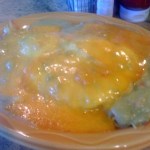Liveblogging
The last day of QIP in Santa Fe. Also note that Joe has posted some nice notes on additivity on his blog: part I and part II. Oh, and QIP next year will be in Zurich, and QIP the year after next will be in Singapore.
computing, conference, quantum
Lluis Masanes, "Towards device-independent security in QKD"
Paper: arXiv:0807.2158. I cam in late, so was a bit lost. But basically Lluis talked about secret key distillation under weaker assumptions than just assuming quantum theory. It seems that one an do secret key distillation from accessing the correlations that violate Bell inequalities…
Sorry to those who talked in the afternoon yesterday: I ran off to listen to Michael Nielsen talk at the Santa Fe Institute.
Charles Marcus, "Holding quantum information in electron spins"
Charlie gave a talk about the state of quantum computing in solid state quantum dot systems. Things Charlie talked about:
T1 times of single electron spins of 1 second from Mark Kastner's group:
arXiv:0707.1656. Those are long, and it would be awesome to have those for real working devices!
Delft's work on single electron spin manipulations: "Driven coherent oscillations of a single electron spin in a…
A full day today, after a nice break yesterday (went for a run: yeah for altitude making me winded nearly instantly!)
Andrew Childs, "Universal computation by quantum walk
Andrew Childs talked about a subject whose origin can be pretty much tracked back to Feynman in the 1980s. In particular Feynman constructed a model of computing in which you have a time independent Hamiltonian. In today's language this is equivalent to showing that there is a quantum random walk which is universal for quantum computing (though Andrew mentioned that this was a model for classical computing using a quantum…
A half day at QIP.
The reason I'm having a hard time keeping away this morning:
Avinatan Hassidim, "Multi-prover interactive proofs with communicating provers"
Paper arXiv:0806.3982. Avinatan described work he performed with Michael Ben-Or and Haran Pilpel on multiprover interactive proofs in which the prover/verifier communication is quantum and the provers are allowed to communicate classically. One would expect, at first glance, that this model is very weak. For example if we augment the provers with entanglement they can then communicate and this model is equivalent to a single prover…
Having some glitches publishing, so am trying to split up the posts.
Continuing on the quantum information theory beat:
John Smolin (speaker) and Graeme Smith, "Can non-private channels transmit quantum information?"
John began by explaining the stages of grief and how this relates to the demolishing of the two additivity questions (described above.) He also showed a picture of a certain interesting way to achieve computer privacy...similar to those found here:
The work John talked about is described in arXiv:0810.0276. The private channel capacity is the capacity of a quantum channel to…
QIP 2009 started today in Santa Fe, NM. Since the conference organizers have seen it wise to include wireless access, what better excuse for a bit of liveblogging.
Andrew Landahl gave us a nice introduction to QIP and explained the New Mexico State question (I'm thinking of starting a movement in California to have a state answer. If you've ever lived in California, you'd understand.) He mentioned that New Mexico has a spaceport, but forgot to ask if anyone arrived yesterday via the spaceport. Anyone? Rosewell?
Then....let the talks begin!
Matt "Michael Phelps" Hastings, "A…
Yes we work on Saturdays. Okay work may be the wrong word. Updated as the day goes along and my brain doesn't fill up (plus I'm chairing a session, so is it ethical to chair and blog at the same time?)
The first talk of the morning was by Edward Farhi. Farhi talked about the NAND tree algorithm (see the Optimizer along with quant-ph/0702144 and its plethora of follow up works.) This was only the second computer talk Farhi has given. That's right, hell has frozen over, and MIT physic professors have given up transparencies and are now using computers. I feel like an era has come to pass…
I've never live blogged before (well I've been alive while I've blogged, but that is different, I guess), but maybe it will make me pay more attention to the talks, so here goes nothing. Oh, and happy Hallmark(TM) Valentines day! I'll be updating these posts as the conference goes along.
John Martinis led a tutorial on measuring coherence in one qubit (Rabi flopping, Ramnsey interference, lifetimes, spin echo), measuring fidelities of one qubit gates, and process tomography for one and two qubit systems. All illustrated with beautiful experimental data from his group at UCSB.
Most…
